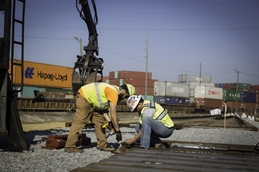
The Port of Savannah is aiming to boost its traffic serving the US Midwest. It has partnered with St. Louis Regional Freightway to set up a new rail terminal that will double its rail lift capacity to about 1 million TEUs.
The new facility, which has a US$220 million price tag, is due to open next year. It will be the largest on-terminal rail facility in North America.
According to the Georgia Ports Authority (GPA), which oversees the ports of Savannah and Brunswick (a major automotive gateway, handling chiefly Ro-Ro traffic), the new facility will enable CSX and Norfolk Southern, the two Class I rail carriers that serve Savannah, to deliver faster and more frequent service to the Midwest.
Much of Savannah’s growth has been driven by economic expansion in Georgia, but the port authority has a much larger market area in its sights. Speaking at the presentation of a major expansion project last year, GPA executive director Griff Lynch outlined its strategic orientation.
“We’re preparing to redefine the port of Savannah as not simply the load centre for the Southeastern US, but as the port of choice for major inland markets east of the Mississippi River,” he said then.
This drive has also led to the establishment of inland ports to feed traffic to Savannah. A year ago, GPA opened the Appalachian Regional Port, an intermodal facility almost 400 miles from the port, which is equipped to handle 100,000 containers a year.
Last November it announced plans for another inland distribution facility in northeastern Georgia, with a connecting rail line operated by Norfolk Southern.
Logistics providers are latching on the port’s growth. In late May Averitt Express opened an international distribution center in the vicinity. It has 44 dock doors and over 80,000 sq ft of warehouse space.
The expansion of the port’s catchment area goes hand in hand with the rising tide of ultra-large container vessels (ULCVs) calling at major US gateways. In mid-May Savannah welcomed the COSCO Development, at 13,092 TEU the largest container ship to berth at a US East Coast port so far.
“The COSCO Development is the start of a new era in the East Coast container trade,” said Lynch. “With their shift to larger, more cost-effective vessels, the shipping lines are gravitating toward gateway ports.”
There is no doubt that GPA sees Savannah as one of those gateways. Operating the largest single-terminal container facility in the US, the port has outpaced all major US ports between 2007 and last year, showing compound average growth of 4.5% a year for the 2007-2017 period.
Other ports in the southeastern US have also enjoyed robust growth, fuelled by the shift of economic activity to the region and, more recently, by the expansion of the Panama Canal. The South Carolina Ports Authority recently posted a record throughput of 204,457 TEU in May, which put its momentum for the fiscal year so far to 9.7% growth.
Savannah set a new record in March, when it handled over 410,000 TEU, an increase of 15.5%. Rail volumes were up 26% to 82,135 TEU, reflecting the growing inland reach of the port.
GPA proudly points to its performance record, which shows a record low dwell time for intermodal containers in March, with average transfers from vessel to rail of 27 hours.
When the COSCO Development called, the port used six cranes to move 10,000 TEU during the ship’s 30-hour dwell at the dock. According to the GPA, this translated into a net berth productivity of 220 moves per hour.
Further expansion of landside capacity is necessary to match the port’s ambitions in the water. In February the GPA announced an expansion programme that will enable Savannah to handle six 14,000 TEU vessels simultaneously. Currently it can cope with three such behemoths at a time.
The GPA wants to ramp up capacity from currently 5.5 million TEU to 8 million by 2028, while the contingent of ship-to-shore cranes is set to rise from currently 30 to 42 units.
By Ian Putzger
Correspondent | Toronto




